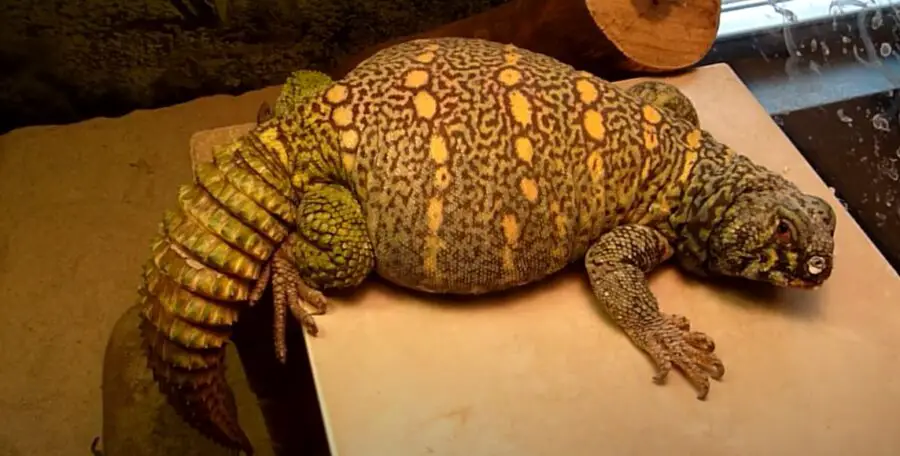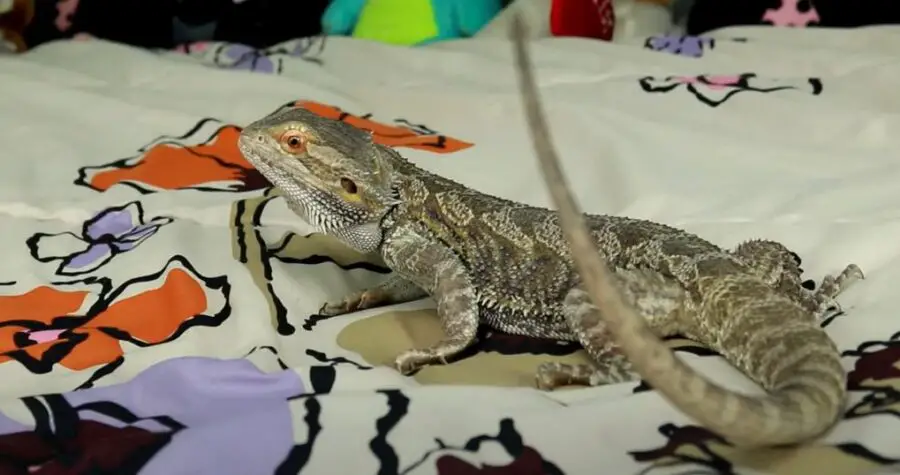My uromastyx is lazy during the winter. Do Uromastyx brumate?
Why, where, when and how do uromastyx brumate? What are the signs of brumation? What are the benefits?
In this article, we will focus on uromastyx brumation to fully understand this phenomenon.
Do Uromastyx Brumate?
Yes. A uromastyx will brumate where their metabolism and activity levels slow down. Brumation occurs during the winter months. A uromastyx during the winter could be:
- largely inactive
- sleeping most of the day
- hiding excessively
- not eating
- eating occasionally
- roaming and basking only a few hours a day
Brumation lasts 1-3 and even 4 months during winter time. Forcing brumation by lowering the heat is not necessary.
This is of more experienced keepers who wish to breed uromastyx. Weigh them every 2 weeks to make sure they are not losing weight and keep them hydrated.

Do Uromastyx have to Brumate?
No. During colder months in the wild, it is a good idea for uromastyx to live off the fat reserves they keep in their tails and elsewhere.
They won’t eat much, sleep a lot and not lose weight. It’s similar to hibernation, but they can still roam around and enjoy some basking time under the sun before returning to their inactive slumber and resting to conserve energy.
In captive situations where we adjust temperatures all year round, we do not have to force a uromastyx to brumate. If the conditions are right for them and they feel the drop of temperatures on colder winter nights, they may wish to brumate.
If you monitor and adjust temperatures accordingly, your uromastyx may wish to enjoy the warmth of winter indoors with plenty of food available. This means that brumation in captivity is not essential.
When it comes to uromastyx temperature and humidity requirements, there’s no better source of information than right here.
Why is My Uromastyx Hiding?
A shy, skittish uromastyx may hide more than others. Young juveniles may also hide out of fear. This a an lizards with many known predators in the wild.
Hiding is their defense mechanism. Another big reason why you might not be seeing your uromastyx often in the colder months is due to brumation.
The main reasons are as follows:
- Stress
- Acclimation
- Too hot
- Too cold
- Anxious
- Not adjusted to you or surroundings yet
- Ill/malnourished
- Recent changes to enclosure
- Too Noisy
- Stuck Shed
- Too much foot traffic from people or pets
- Brumation
Once again, brumation is where you uromastyx hides, sleeps or rests for the better part of the day and night over winter months when they feel a drop in temperatures.
As long as they are not losing weight, they won’t eat much and that’s ok for now. Weigh them every 2 weeks to monitor any changes.

When Do Uromastyx Brumate?
Brumation for your uromastyx will depend on which months of the year in your city are the coldest. For us, our uromastyx brumates over the winter from late autumn to late winter.
How long does uromastyx brumate? In our case it’s anywhere from 8-12 weeks a year. This is not set in stone because we have created indoor ecosystems for our reptile companions now and we adjust their temperatures in their enclosures.
If your uromastyx was in the wild, they would feel the drop in temperature more and begin to brumate. If they feel warm, they may reduce the length of brumation or skip it altogether.
Temperature and humidity changes are huge factors. See why this is an important topic to explore.
Where Do Uromastyx Brumate?
Have you set up ample hiding spaces for your uromastyx? You can get creative with adding decorations or plants. There would be:
- cool areas
- a basking area
- layer of substrate
They can climb, burrow and hide behind any items in the enclosure. Cool areas can drop in temperature as low as 50-60 degrees Fahrenheit.
A uromastyx will brumate under these conditions, come out to bask and spend most of the time sleeping until temperature warms up again.
My uromastyx likes to dig more than anything else and he brumates under a thin layer of substrate at the bottom of his cage. His heart rate decreases and he eats every few days.
I don’t leave food in there to rot if he ignores it after a 5-10 minutes of placing it in there. Try again tomorrow and weigh them every 2 weeks to make sure they are not getting thin.

Why do Uromastyx Brumate?
A uromastyx has to brumate for the following reasons:
- When temperatures drop
- Conserve energy
- Lower metabolism when food and water is scarce
- Lower heart rate
- Reduce body temperature
- Less daylight
- Less sunshine
- Encourage breeding
If you are an experienced caregiver of uromastyx, you know that reducing temperatures can assist in creating the right conditions for your uromastyx to breed when they come out of brumation.
If you do not intend to breed uromastyx, you should never force this process by lowering temperatures in their enclosure. If these lizard pets feel a drop in nighttime temperatures, they may desire to brumate.
If none of the reasons why uromastyx brumate are not present during the winter,. There is no need for them to undergo this natural state similar to hibernation.
Will you need to give them water? See what needs to be done with uromastyx hydration here.
Do Uromastyx Eat During Brumation?
Sometimes. When a uromastyx has enough fat stores in their tails and elsewhere throughout their entire length, these lizards can stop eating for weeks.
Some uromastyx may eat and defecate a little during brumation while others do not. This period is called the winter cooldown. It is possible for them to go months without eating.
When I feed my uromastyx 2-4 times a week and keep the temperature warm enough, he doesn’t care to fall into deep brumation where he completely fasts. He can drink, eat and go back to being lazy without fully knocking out and sleeping all winter.
Signs of Brumation
- Spending fewer amounts of time in basking areas.
- Moving to cooler areas of enclosure.
- Loss of appetite.
- Sleeping a lot longer
- Looking for dark places to hide
- digging to create a nesting burrow.
A stuck shed for uromastyx is related and necesary for me to share as well. Take a moment to look at this article on it.
Thank you for visiting PocketPetCentral.com for the best information to help you enjoy the life of your pocket pet companion in a fun, safe & healthy way.

